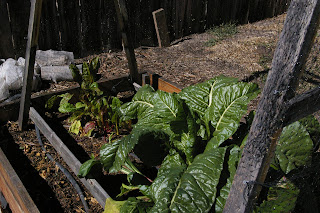Like this blog, my garden was neglected this winter due to cold and snow and distractions. I can't think of a better way to get into my spring garden than with a discussion of peas.
I planted 2 types today, a shell pea and a snap pea. I plant them side by side and have been doing so for a few years.
The first step is to determine a location and either establish a support structure or make a plan for one because once peas get growing, they need support to climb on.
This spring, I'm planting my peas here with stakes about 6 feet across and a bamboo pole on top. I'll build additional support as the peas grow with twine as they come up or might use some left over wire fence pieces, I haven't decided yet. In the background is an A-Frame structure that I've also used for climbing peas in the past, and it works on the same principle.
Next prepare the soil with some compost or and create furrows about 1" deep for planting. These are about 6" apart.
Of course, you're going to need peas, these are the ones I'm using today. I also use legume inoculant with all of the beans and peas that I plant. There is some debate as to whether this is really necessary if you have planted beans or peas in this location before because theoretically the beneficial bacteria should still be in the soil. An envelope of inoculant costs $3-5 and a little goes a long way so I figure that it can't hurt. I sprinkle it in the furrow right before my seeds. Some people say that you need to soak seeds and inoculant in water or milk together first to get good germination, but I honestly have not noticed much difference when adding these steps.
Then plant those seeds, water, hill up a little, label, and you're done.
Germination usually takes 1-2 weeks but can take longer if you get a cold snap.
One additional note that I have on peas is a recommendation for bird netting once they sprout. I'll drape some over the top of the support structure and anchor to the soil with landscaping stakes. At least in my yard, if you don't net your peas you will go out 1 morning to what looks like a weed whacker destruction site. Birds ... love them, but keep them off your peas.
Now fast forward to pea success ...
Once they get going they really grow quickly.
And then you get to eat meals like this, fresh pasta with peas and herbs. Delicious.
I hope this inspires you to get out and plant some peas if you haven't already.
Happy (almost) Spring!


























